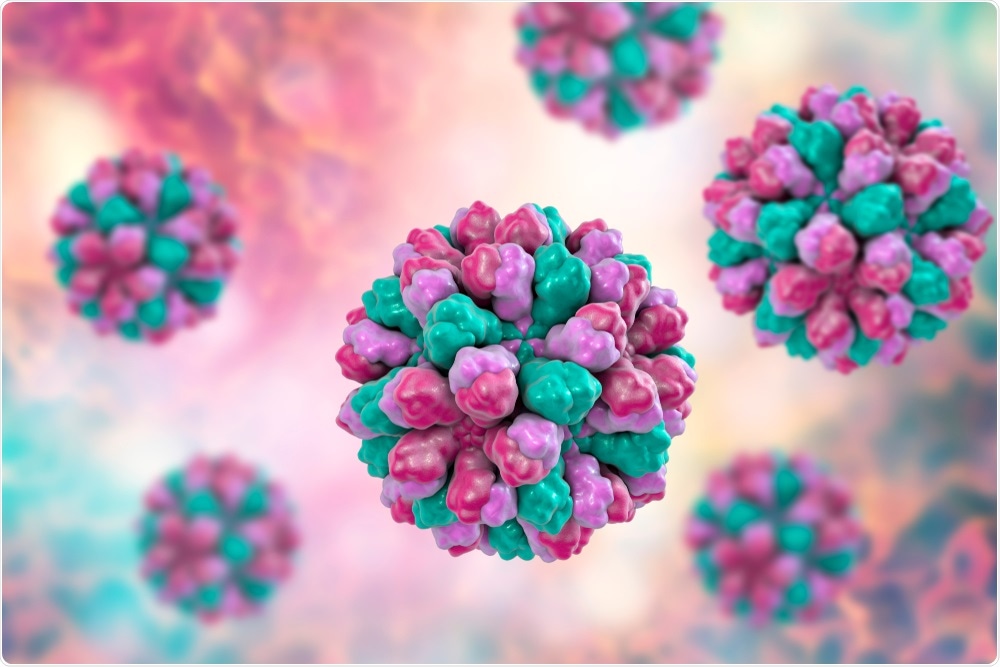Noroviruses can be easily transported via fresh fruits and vegetables which is a major problem especially given that this group of viruses is the major cause of gastroenteritis in the developed world.

Image Credit: Kateryna Kon/Shutterstock.com
Last month, a team from the Institut National de la Recherche Scientifique (INRS) in Canada published the findings of their study in the Journal of Applied Microbiology describing how they established a technique that combines fruit extracts and irradiation to restrict the spread of foodborne infections.
A need for a method to eliminate noroviruses from fresh produce
Fresh produce presents an opportunity for noroviruses to infect large numbers of people. The group of contagious viruses cause vomiting and diarrhea in humans and is the number one cause of gastroenteritis in the US.
While irradiation is successful at wiping out bacteria, insects, molds, and parasites that may be harbored on fruit and vegetables, it is largely ineffective at eliminating viruses. This is because the level of gamma rays or X-ray radiation that is used to clean the produce of these other invading substances is not strong enough to harm viruses and raising the level of radiation would detrimentally impact the physicochemical properties of the food.
Therefore, there is a strong need for a safe and reliable method for eliminating noroviruses from fresh produce. Scientists based at INRS in Quebec, Canada, aimed to develop a method to inhibit virus activity, making food safe from transmitting the harmful norovirus.
The team was inspired by the properties of fruit extracts, which contain organic acids and polyphenol that are can alter proteins, such as those that construct viruses.
The idea was to develop a spray made of these fruit extracts to be applied to fresh produce before it is treated with irradiation as a method to eliminate noroviruses without damaging the food’s quality.
Combining a fruit extract spray with irradiation
Usually, to ensure noroviruses are eliminated from food, an irradiation dose of three kilograys (kGy) is required. However, it is not possible to apply these strong levels of irradiation to food that is intended for human consumption.
Therefore, the Canadian research team explored a way they could enhance the efficacy of using half these levels of radiation by adding a spray made out of organic acids and polyphenol extracted from cranberry juice and citrus fruits.
The fruit spray works as a natural antimicrobial agent that preserves the freshness of the produce by eliminating microbes that would contribute to cell breakdown. Scientists found that spraying this fruit extract mix onto produce before exposing it to irradiation was effective at eliminating norovirus contaminations on fresh produce.
Results showed that the combination of the methods was significantly more effective than using irradiation on its own,
The scientists tested the method on one of the most fragile vegetables, lettuce, to test that the process was gentle enough to not destroy the produce. The results were positive, demonstrating that even the most vulnerable of produce types could be treated this way.
Developing the test at the commercial scale
The findings of this research are important because not only do they demonstrate a new method that could be used to safely wipe out noroviruses from fresh produce, but it is also one of the few scientific studies that have explored the use of plant extracts as an anti-norovirus agent.
While the benefits of using plant extracts to fight infectious diseases have been known for hundreds of years, and modern science has been able to back up the effectiveness of some natural substances, little research has been conducted into the effects of plant extracts against norovirus.
Therefore, this research is important in opening up a new avenue of scientific exploration which may lead to effective prevention methods.
In this case, the Canadian team plan to continue to advance their method and are looking to partner with the food industry to explore different combinations of natural fruit extracts with cold pasteurization, to develop the method on a commercial scale.
Source:
Journal references:
Caillet, S., Côté, J., Doyon, G., Sylvain, J. and Lacroix, M. (2011). Antioxidant and antiradical properties of cranberry juice and extracts. Food Research International, 44(5), pp.1408-1413. https://www.sciencedirect.com/science/article/abs/pii/S0963996911001062
Côté, J., Caillet, S., Doyon, G., Sylvain, J. and Lacroix, M. (2010). Bioactive Compounds in Cranberries and their Biological Properties. Critical Reviews in Food Science and Nutrition, 50(7), pp.666-679. https://www.ncbi.nlm.nih.gov/pubmed/20694928
Gobeil, A., Shankar, S. and Lacroix, M. (2020). Radiosensitivity increase in FCV‐F9 virus using combined treatments with natural antimicrobials and γ‐irradiation. Journal of Applied Microbiology. https://www.ncbi.nlm.nih.gov/pubmed/31991509